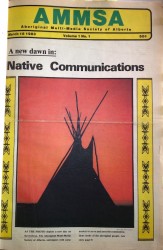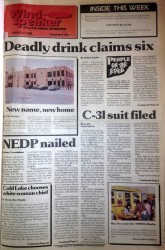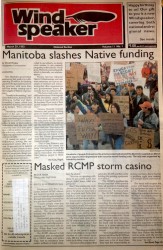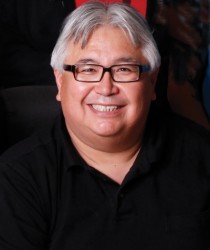Article Origin
Volume
Issue
Year
Windspeaker, a name synonymous with Aboriginal news, is celebrating its 30th anniversary of publishing this year. The magazine has a rich history.
Starting as a small Alberta publication, Windspeaker grew to a national magazine that many people rely on to this day.
Staff who have been with the publication from the beginning take pride in many things, including the consistent quality of work Windspeaker has produced over the decades, the guidance it has provided to young reporters, and the struggle to maintain an Aboriginal news publication through good times and bad.
Publisher and CEO Bert Crowfoot acknowledges that he has come a long way from when he began as a freelance sports reporter in the 1970s.
“I wanted to be a coach so I was taking education and sports [at university],” he said. “My friend offered me a job as a freelance sports writer and I covered a basketball tournament and a hockey tournament and took pictures. He liked what I did so he offered me a full-time job.”
In the early 1980s, Crowfoot left his job and started a newspaper in his basement with a friend, which only lasted a couple of years.
When the federal government sent out a call for proposals for grants to publish in the Aboriginal market, Crowfoot jumped at the chance to apply.
He was approved in early March 1983, and the first issue of AMMSA was created in the boardroom of the Secretary of State and published on March 18, 1983.
AMMSA stands for Aboriginal Multi-Media Society of Alberta, the name of the organization that publishes Windspeaker. The paper’s name was changed to Windspeaker from AMMSA in 1986 after a public naming contest. Windspeaker won out over other names, including “Spirit Voices.”
“The first four years were tough,” said Crowfoot, but an entrepreneurial spirit within him served the organization well.
“We started running our not-for-profit corporation like a business. Since 1990 we’ve been self-sufficient on the publishing side.
Windspeaker has stuck around for the past 23 years (independent of any government grants).”
Director of publishing and marketing Paul Macedo also takes pride in Windspeaker’s 30 years of staying power. Since 1990, he has guided the revenue side of the many-faceted AMMSA organization, which also includes a popular radio station, and he oversees all publishing operations now.
He said Windspeaker’s government funding was completely cut just two months after he started in 1990.
“They announced that the funding was gone… that funding not only helped Windspeaker, but helped 11 other Aboriginal publishers across the country,” said Macedo.
“In the period of two to three months following that announcement, only two publications survived, and survived to this day. And that’s Windspeaker and Wawatay News.”
Macedo also takes pride in the fact that Windspeaker, once a small Northern Alberta newspaper, has become national while keeping its local charm.
“As Windspeaker went national, and left a void locally, we then filled that void by producing Alberta Sweetgrass,” he said.
“Over time we did the same thing for Saskatchewan with the launch of Saskatchewan Sage, and then in B.C. with the launch of Raven’s Eye, and in Ontario with the launch of Ontario Birchbark. That was all done without any (government) funding, whatsoever, but through self-generated revenues. That was an amazing feat.”
Macedo said he is also proud of the fact Windspeaker has helped to nurture young journalists.
“I’m proud of the quality of work that we’ve done, and I’m proud of the people that have worked and contributed to Windspeaker,” he said.
“So many people have come and then gone on to phenomenal careers… We like to think we played a small part in their development.”
To Crowfoot, the thing that fills him with pride is that Windspeaker has been a consistently objective and relied-upon news source.
“To me the most important role that Windspeaker has played over the years is that it has provided unbiased, objective coverage of all news stories,” he said.
“We’ve taken on Indian leaders, we’ve taken on non-Indian leaders, we’ve taken on ministers, we’ve taken on grassroots people. But all along, because of Debora (Steel)—I give her credit—we have always strived to maintain that objectivity in all our stories.”
Steel began at AMMSA as a national news reporter in 1993, and was editor-in-chief of the five publications when she left the full-time employ of AMMSA in late 2006. She remains, however, linked to Windspeaker as a contributing editor.
According to Crowfoot, Steel has been the most vital part of the magazine’s consistently high journalistic standards. To him, she is the one who worked behind the scenes, providing sober second thought and encouragement to a talented crew of writers.
“I’ve learned many things working with Bert over 20 years,” Steel said. “‘Surround yourself with good people and then get out of their way’ is one piece of advice he likes to give. I surrounded myself with good solid reporters who were devoted to the work. My job, as I came to view it, was to provide a safe place where they could do that work in the knowledge that we had their backs.”
“She did an awesome job of going through the news and figuring out what was newsworthy. And finding the news,” Crowfoot said.
“There’s a huge difference between journalists and activists, and unfortunately there’s a huge number of activists who are journalists. (Deb) really understood that difference.”
Crowfoot emphasized the importance of Aboriginal media and the need for the Aboriginal worldview to be seen in the press.
“Aboriginal media’s role—like APTN and all these other groups—is they’re telling the stories from our perspective,” he said.
- 2996 views




